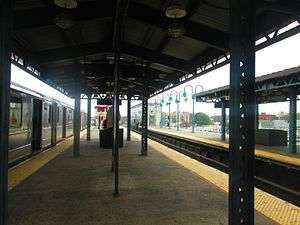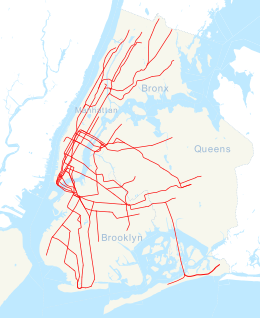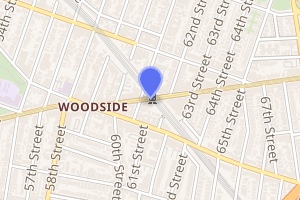61st Street–Woodside station
61st Street–Woodside (announced as Woodside–61st Street on rolling stock) is an express station on the IRT Flushing Line of the New York City Subway located at 61st Street and Roosevelt Avenue in Woodside, Queens. It is served by the 7 train, with additional peak-direction <7> service during rush hours.
61 Street–Woodside | |||||||||
|---|---|---|---|---|---|---|---|---|---|
 Platform view | |||||||||
| Station statistics | |||||||||
| Address | 61st Street & Roosevelt Avenue Woodside, NY 11377 | ||||||||
| Borough | Queens | ||||||||
| Locale | Woodside | ||||||||
| Coordinates | 40°44′44.19″N 73°54′10.68″W | ||||||||
| Division | A (IRT) | ||||||||
| Line | IRT Flushing Line | ||||||||
| Services | 7 | ||||||||
| Transit connections | |||||||||
| Structure | Elevated | ||||||||
| Platforms | 2 island platforms cross-platform interchange | ||||||||
| Tracks | 3 | ||||||||
| Other information | |||||||||
| Opened | April 21, 1917 | ||||||||
| Station code | 456[1] | ||||||||
| Accessible | |||||||||
| Opposite-direction transfer available | Yes | ||||||||
| Former/other names | Woodside–61st Street 61st Street | ||||||||
| Traffic | |||||||||
| Passengers (2019) | 5,345,369[2] | ||||||||
| Rank | 84 out of 424[2] | ||||||||
| Station succession | |||||||||
| Next north | Junction Boulevard (express): <7> 69th Street (local): 7 | ||||||||
| Next | Junction Boulevard (express): <7> 74th Street–Broadway (local): 7 | ||||||||
| Next south | 52nd Street (local): 7 Queensboro Plaza (express): <7> | ||||||||
| Next | Court Square: 7 | ||||||||
| |||||||||
| |||||||||
| |||||||||
History
61st Street–Woodside opened on April 21, 1917 as Woodside, as part of an extension of the IRT Flushing Line to Alburtis Avenue (now 103rd Street–Corona Plaza). The Long Island Rail Road station predates the station, as it originally opened in 1869.
The platforms at 61st Street were extended in 1955–1956 to accommodate 11-car trains.[3]
In 1981, the MTA listed the station among the 69 most deteriorated stations in the subway system.[4]
As part of the 2015–2019 Capital Program, the MTA would renovate the 52nd, 61st, 69th, 82nd, 103rd and 111th Streets stations, a project that has been delayed for several years but is slated to begin in mid-2020. Conditions at these stations were among the worst of all stations in the subway system.[5]
Station layout
| 3F Subway platforms |
Southbound local | ← |
| Island platform | ||
| Peak-direction express | ← | |
| Island platform | ||
| Northbound local | | |
| 2F | Mezzanine | Connection between subway and LIRR, station agent, MetroCard machines
|
| 1F LIRR platforms |
Platform C, side platform | |
| Track 1 | ← Port Washington Branch toward Penn Station (Terminus) | |
| Track 2 | Port Washington Branch toward Great Neck or Port Washington (Mets–Willets Point or Flushing–Main Street) → | |
| Platform B, Island platform | ||
| Track 3 | ← Main Line services toward Penn Station (Terminus) | |
| Track 1 | ← Main Line services does not stop here → | |
| Track 2 | ← Main Line services does not stop here → | |
| Track 4 | Main Line services toward Jamaica and Points East (Forest Hills) → | |
| Platform A, side platform | ||
| G | Street level | Entrances/exits |
This station has two island platforms and three tracks. The two outer tracks are used for the full-time 7 local service while the bidirectional center track is used for rush hour peak-direction <7> express service.[6] There is a mezzanine located at the center, underneath the platforms, with an ADA-accessible elevator to each platform, as well as another to each Long Island Rail Road platform. The elevator from the mezzanine to the street stops at the LIRR's eastbound Main Line platform.
Artwork includes John Cavanagh's Commuting/Community (1986), located near the stairway down to LIRR Track 4, and Dimitri Gerakaris' Woodside Continuum (1999), which forms part of the steel-grating fare-control separation.
Exits
Entrance and exit are provided by long stairs down to street level on the northern curb of Roosevelt Avenue at 61st Street, as well as to other nearby locations via the LIRR platforms. An ADA-compliant elevator provides access to street level at the northeast corner of 61st Street and Roosevelt Avenue, while a long escalator at the southeast corner provides entrance only. The Woodside station of the Long Island Rail Road is located directly beneath the Flushing Line station; any of the three LIRR platforms can be accessed directly from the mezzanine.
In popular culture
This station was used for a scene in John Cassavetes's 1980 film Gloria. The station was depicted in a scene in the Coen brothers' 2013 film Inside Llewyn Davis, though actual filming occurred elsewhere.
References
- "Station Developers' Information". Metropolitan Transportation Authority. Retrieved June 13, 2017.
- "Facts and Figures: Annual Subway Ridership 2014–2019". Metropolitan Transportation Authority. 2020. Retrieved May 26, 2020.
- Authority, New York City Transit (January 1, 1955). Minutes and Proceedings.
- Gargan, Edward A. (June 11, 1981). "AGENCY LISTS ITS 69 MOST DETERIORATED SUBWAY STATIONS". The New York Times. Retrieved August 13, 2016.
- "MTA To Overhaul Six Stations on the 7 Line, Currently in Design Phase". Sunnyside Post. November 19, 2019. Retrieved April 29, 2020.
- Dougherty, Peter (2006) [2002]. Tracks of the New York City Subway 2006 (3rd ed.). Dougherty. OCLC 49777633 – via Google Books.
External links
| Wikimedia Commons has media related to 61st Street – Woodside (IRT Flushing Line). |
- nycsubway.org – IRT Flushing Line: 61st Street/Woodside
- nycsubway.org — Commuting/Community Artwork by John Cavanagh (1986)
- nycsubway.org — Woodside Continuum Artwork by Dimitri Gerakaris (1999)
- Station Reporter — 7 Train
- The Subway Nut — 61st Street–Woodside Pictures
- MTA's Arts For Transit — Woodside–61st Street (IRT Flushing Line)
- 61st Street entrance from Google Maps Street View
- Station as seen from the LIRR platforms from Google Maps Street View
- Platforms from Google Maps Street View



